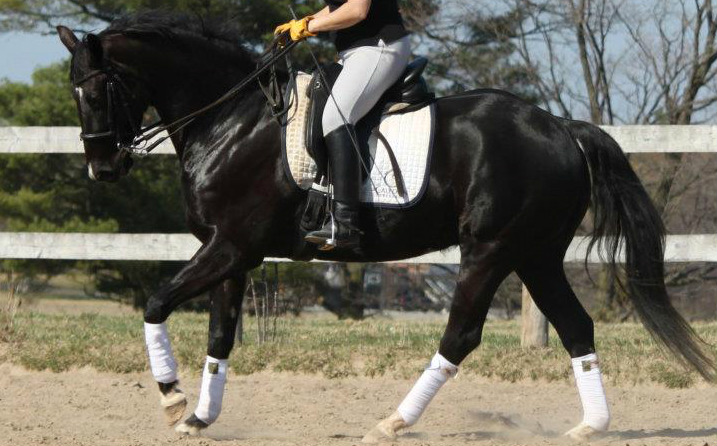I am thrilled to have Kathy from Horse Listening as our FIRST guest blogger here on EQ! Kathy has been involved in the equine industry for the past 20 years as a rider, boarder, horse owner, competitor, coach, trainer, and breeder. Horse Listening, the blog, is especially for people who spend time with horses because of their passion, attraction and love for the horse.
When the horse is using their back properly the large longissimus muscle, which runs along the length of the back, contracts in a wave-like pattern as the horse transfers impulsion from the hind-end across the back. In a state of complete contraction the longissimus has the action of hollowing the back – preventing the horse from really being able step under themselves and engage the hind-end. In this post Kathy talks about feeling the difference as a rider, and why it matters to your horse.
This article was originally posted here.

Good use of back for this particular horse. Note the deep-stepping inside hind leg, the weight slightly shifted back, the light front end, the calm, confident expression.
How do you know your horse is using his back?
Let’s face it: we see many people riding their horses with sunken backs, disengaged hind ends, and heavy footfalls. If they do it, why shouldn’t we? Are we being conceited, ostentatious, pompous or pretentious?
Are we simply just too picky?
No, it’s none of the above.
It’s because we care.
Enough.
To put in the work.
Because it’s a fact: learning to feel the back of the horse, especially in movement, is not for the weak-hearted.
It requires hours of dedicated practice oodles of lesson dollars, numerous requests for forgiveness from the horse, and perhaps most difficult of all, countless adjustments to our internal neural pathways, both physical and mental.
Is all this worth it?
OF COURSE IT IS!
In the long run, our primary motivation for self-improvement in riding is for the sake of the horse’s health. We want horses that live well, staying strong and vigorous long into their old age. And a horse that uses his back is carrying the rider’s weight to his best advantage.
Feel it.
The round back feels loose, bouncy, rolling, supple. It feels like the horse is having an easy time carrying your weight. He is less on his front legs and more on the haunches.
He gives you the impression that he can stop on a dime or turn on a thought. He is forward, active and content. The energy from the hind end easily flows through the shoulders and you notice larger, longer strides, and bouncier, more active gaits.
If you have trouble with the sitting trot, (you might be shocked to discover that) you might have even MORE trouble riding the trot of a horse that is using his back. This is because the horse’s natural gaits become amplified when the back moves freely. You’d be better off posting so that you can encourage your horse to keep his soft, active back.
The same is true with the canter – the strides are more exaggerated and you feel more swing in the ride. Be prepared to let your lower back flow with the activity – anything less and you’ll be stifling the horse’s enthusiastic offering.
Basically, if you feel the gaits getting bigger, rounder, bouncier and maybe a bit harder to ride, then you know you are on the right track!
The Tight Back…
… feels just that – tight.
… restricts the movement of the legs.
… creates short, choppy strides that lurch and jerk.
… prevents establishment of a good forward-flowing rhythm.
… causes the horse to move on the forehand, taking the brunt of the concussion on the front legs.
… can be the culprit behind sore backs and “mystery” lamenesses.
The irony is that the horse can appear to be more “comfortable” to ride, in that the movement is smaller and shorter and thus easier for most riders to follow. If you think your horse feels smooth and comfortable, consider whether or not the smooth feeling is caused by the horse locking his back and preventing movement. Your first clue will be in the size of the stride – if it is a short stride, particularly in the hind legs, then the horse in NOT using his back.
For those of you who are visual learners like I am, watch the following video. Will Faerber does a terrific job in showing clearly a horse using its back versus the “dropped” back.
How to Engage your Horses Back by Master Horseman/Classical Dressage Trainer Will Faerber.


